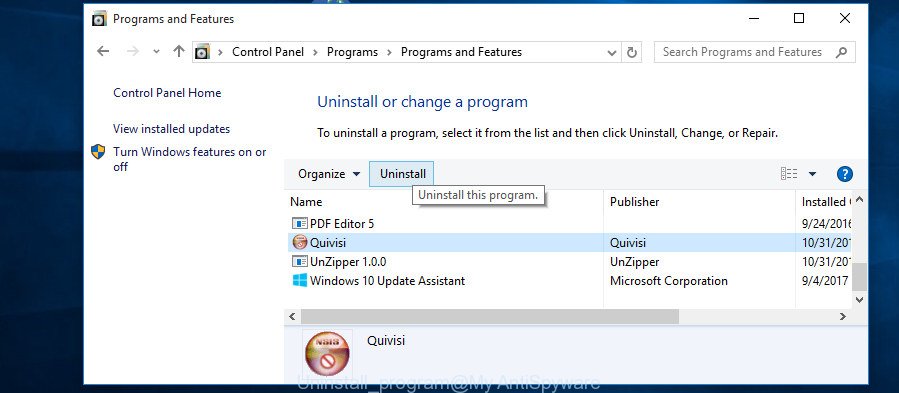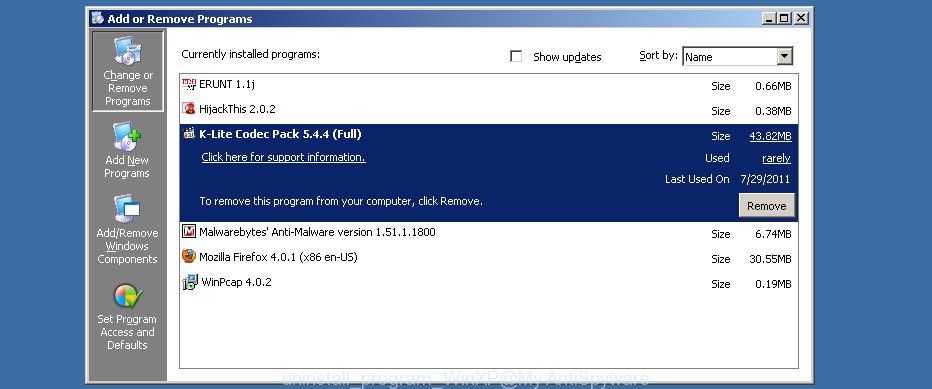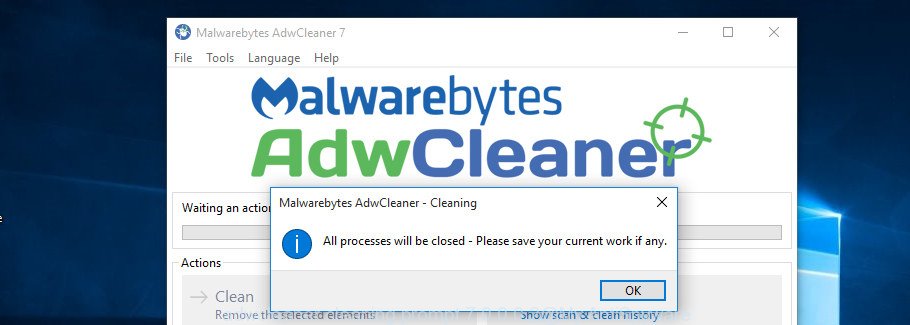There are certain potentially unwanted apps known as hijackers that once get installed onto your machine alters your Google Chrome, Firefox, MS Edge and Internet Explorer internet browser, replace your start page with an unwanted one, set a search provider that may redirect your internet queries to pages with intrusive ads and pop ups. You are probably reading this post because your personal computer is affected by SecurySearch browser hijacker and you are looking for method to remove it.
Besides the fact that SecurySearch browser hijacker modifies your startpage, it can set yourself as your search engine. But, obviously, it does not give you a good search results, as they will consist of lots of ads, links to undesired and ad web-pages and only the remaining part is search results for your query from the major search engines. Of course, the very fact that you encounter with the inability to properly search the World Wide Web, is an unpleasant moment. Moreover, the SecurySearch hijacker can collect a wide variety of your user info. This confidential data, in the future, may be sold to third parties. What creates the risk of theft of your privacy data.
Also, ‘ad-supported’ software (also known as adware) can be installed on the PC system together with SecurySearch hijacker. It will insert a lot of advertisements directly to the pages that you view, creating a sense that advertisements has been added by the makers of the web-page. Moreover, legal advertisements can be replaced on fake ads which will offer to download and install various unnecessary and harmful apps. Moreover, the SecurySearch hijacker infection can gather lots of confidential data about you that can be later transferred third party companies.
So, it is very important to free your computer of browser hijacker infection as quickly as possible. The few simple steps, which is shown below, will assist you to remove SecurySearch redirect from the Google Chrome, Firefox, IE and MS Edge and other web browsers.
Remove SecurySearch redirect
In the guide below we will have a look at the browser hijacker infection and how to get rid of SecurySearch from Google Chrome, Microsoft Internet Explorer, Firefox and MS Edge browsers for Windows OS, natively or by using a few free removal tools. Read it once, after doing so, please print this page as you may need to close your browser or reboot your computer.
To remove SecurySearch, execute the steps below:
- How to get rid of SecurySearch homepage without any software
- SecurySearch redirect automatic removal
- Stop SecurySearch redirect and other annoying web-sites
- Don’t know how your web browser has been hijacked by SecurySearch hijacker?
- Finish words
How to get rid of SecurySearch homepage without any software
The few simple steps will help you remove SecurySearch redirect. These SecurySearch removal steps work for the Chrome, Firefox, IE and Edge, as well as every version of Windows operating system.
Delete SecurySearch associated software by using Microsoft Windows Control Panel
Check out the MS Windows Control Panel (Programs and Features section) to see all installed software. We suggest to click on the “Date Installed” in order to sort the list of applications by the date you installed them. If you see any unknown and suspicious programs, they are the ones you need to delete.
Make sure you have closed all internet browsers and other apps. Press CTRL, ALT, DEL keys together to open the Microsoft Windows Task Manager.

Click on the “Processes” tab, look for something suspicious that is the browser hijacker infection that responsible for internet browser redirect to the annoying SecurySearch page then right-click it and select “End Task” or “End Process” option. Most often, malicious software masks itself to avoid detection by imitating legitimate Microsoft Windows processes. A process is particularly suspicious: it is taking up a lot of memory (despite the fact that you closed all of your programs), its name is not familiar to you (if you are in doubt, you can always check the application by doing a search for its name in Google, Yahoo or Bing).
Next, uninstall any unwanted and suspicious programs from your Control panel.
Windows 10, 8.1, 8
Now, click the Windows button, type “Control panel” in search and press Enter. Select “Programs and Features”, then “Uninstall a program”.

Look around the entire list of programs installed on your PC. Most probably, one of them is the hijacker which made to redirect your internet browser to the SecurySearch page. Select the suspicious application or the program that name is not familiar to you and delete it.
Windows Vista, 7
From the “Start” menu in MS Windows, select “Control Panel”. Under the “Programs” icon, choose “Uninstall a program”.

Select the suspicious or any unknown software, then click “Uninstall/Change” button to uninstall this unwanted program from your computer.
Windows XP
Click the “Start” button, select “Control Panel” option. Click on “Add/Remove Programs”.

Select an undesired program, then click “Change/Remove” button. Follow the prompts.
Remove SecurySearch redirect from Chrome
Reset Google Chrome settings is a simple way to remove the hijacker infection, harmful and ‘ad-supported’ extensions, as well as to restore the internet browser’s start page, new tab page and default search provider that have been replaced by SecurySearch hijacker.
First launch the Google Chrome. Next, press the button in the form of three horizontal dots (![]() ).
).
It will display the Google Chrome menu. Choose More Tools, then click Extensions. Carefully browse through the list of installed add-ons. If the list has the extension signed with “Installed by enterprise policy” or “Installed by your administrator”, then complete the following instructions: Remove Google Chrome extensions installed by enterprise policy.
Open the Chrome menu once again. Further, press the option named “Settings”.

The web browser will show the settings screen. Another solution to display the Google Chrome’s settings – type chrome://settings in the internet browser adress bar and press Enter
Scroll down to the bottom of the page and press the “Advanced” link. Now scroll down until the “Reset” section is visible, like below and click the “Reset settings to their original defaults” button.

The Chrome will display the confirmation prompt as shown below.

You need to confirm your action, click the “Reset” button. The web-browser will run the procedure of cleaning. After it is finished, the browser’s settings including newtab page, home page and search provider by default back to the values which have been when the Chrome was first installed on your personal computer.
Remove SecurySearch from Firefox by resetting internet browser settings
If your FF internet browser home page has modified to SecurySearch without your permission or an unknown search engine opens results for your search, then it may be time to perform the browser reset.
First, launch the Firefox. Next, click the button in the form of three horizontal stripes (![]() ). It will open the drop-down menu. Next, press the Help button (
). It will open the drop-down menu. Next, press the Help button (![]() ).
).

In the Help menu click the “Troubleshooting Information”. In the upper-right corner of the “Troubleshooting Information” page click on “Refresh Firefox” button as on the image below.

Confirm your action, press the “Refresh Firefox”.
Remove SecurySearch start page from IE
In order to restore all browser start page, newtab and default search provider you need to reset the Microsoft Internet Explorer to the state, which was when the MS Windows was installed on your personal computer.
First, run the IE, click ![]() ) button. Next, press “Internet Options” as on the image below.
) button. Next, press “Internet Options” as on the image below.

In the “Internet Options” screen select the Advanced tab. Next, click Reset button. The Internet Explorer will display the Reset Internet Explorer settings dialog box. Select the “Delete personal settings” check box and press Reset button.

You will now need to reboot your PC system for the changes to take effect. It will remove hijacker which redirects your internet browser to unwanted SecurySearch web site, disable malicious and ad-supported web browser’s extensions and restore the Internet Explorer’s settings like startpage, new tab page and search provider by default to default state.
SecurySearch redirect automatic removal
After completing the manual removal tutorial above all unwanted apps and web-browser’s add-ons that causes web-browser redirects to the SecurySearch web-site should be removed. If the problem with SecurySearch browser hijacker is still remained, then we suggest to scan your personal computer for any remaining malicious components. Run recommended free browser hijacker removal apps below.
Use Zemana Anti-Malware (ZAM) to remove hijacker
Zemana Anti-Malware (ZAM) is a tool which can remove ‘ad supported’ software, potentially unwanted apps, browser hijackers and other malicious software from your PC easily and for free. Zemana Free is compatible with most antivirus software. It works under Windows (10 – XP, 32 and 64 bit) and uses minimum of PC system resources.
Download Zemana from the following link. Save it on your Desktop.
165033 downloads
Author: Zemana Ltd
Category: Security tools
Update: July 16, 2019
After downloading is complete, close all programs and windows on your computer. Double-click the set up file called Zemana.AntiMalware.Setup. If the “User Account Control” prompt pops up as shown on the screen below, click the “Yes” button.

It will open the “Setup wizard” which will help you install Zemana AntiMalware on your computer. Follow the prompts and don’t make any changes to default settings.

Once installation is finished successfully, Zemana Free will automatically start and you can see its main screen as displayed on the screen below.

Now click the “Scan” button to find hijacker infection which reroutes your internet browser to intrusive SecurySearch web site. This procedure can take some time, so please be patient. While the Zemana Anti Malware is checking, you can see how many objects it has identified either as being malware.

After the scan is finished, Zemana Free will display a list of detected threats. You may move items to Quarantine (all selected by default) by simply click “Next” button. The Zemana will get rid of browser hijacker infection that cause SecurySearch web page to appear and add items to the Quarantine. Once that process is finished, you may be prompted to restart the PC.
How to remove SecurySearch with Malwarebytes
We suggest using the Malwarebytes Free. You can download and install Malwarebytes to find out and remove SecurySearch startpage from your computer. When installed and updated, the free malicious software remover will automatically scan and detect all threats exist on the personal computer.

- Download MalwareBytes AntiMalware by clicking on the following link. Save it directly to your Windows Desktop.
Malwarebytes Anti-malware
327261 downloads
Author: Malwarebytes
Category: Security tools
Update: April 15, 2020
- Once the downloading process is finished, close all software and windows on your PC system. Open a directory in which you saved it. Double-click on the icon that’s named mb3-setup.
- Further, click Next button and follow the prompts.
- Once installation is finished, press the “Scan Now” button to perform a system scan for the browser hijacker that causes browsers to open annoying SecurySearch page. While the MalwareBytes AntiMalware is scanning, you may see number of objects it has identified either as being malware.
- Once the checking is complete, you can check all threats detected on your machine. All detected threats will be marked. You can remove them all by simply click “Quarantine Selected”. When disinfection is done, you may be prompted to reboot your PC.
The following video offers a guidance on how to remove hijacker infections, adware and other malicious software with MalwareBytes Anti-Malware.
Scan your machine and remove SecurySearch redirect with AdwCleaner
AdwCleaner is a free portable application that scans your machine for adware, potentially unwanted apps and hijackers like SecurySearch and allows remove them easily. Moreover, it will also help you remove any harmful internet browser extensions and add-ons.
Download AdwCleaner on your Microsoft Windows Desktop from the following link.
225628 downloads
Version: 8.4.1
Author: Xplode, MalwareBytes
Category: Security tools
Update: October 5, 2024
Once downloading is done, open the file location. You will see an icon like below.
![]()
Double click the AdwCleaner desktop icon. When the utility is opened, you will see a screen as shown in the figure below.

Further, press “Scan” button . AdwCleaner utility will start scanning the whole PC to find out SecurySearch hijacker and other internet browser’s malicious plugins. Depending on your computer, the scan may take anywhere from a few minutes to close to an hour. When the scan is finished, AdwCleaner will display a list of all items detected by the scan as displayed in the following example.

In order to remove all items, simply click “Clean” button. It will open a prompt as displayed on the screen below.

You need to click “OK”. After the clean-up is complete, the AdwCleaner may ask you to reboot your machine. When your machine is started, you will see an AdwCleaner log.
These steps are shown in detail in the following video guide.
Stop SecurySearch redirect and other annoying web-sites
In order to increase your security and protect your personal computer against new annoying ads and harmful web-sites, you need to use adblocker program that stops an access to malicious advertisements and web-sites. Moreover, the program can stop the open of intrusive advertising, that also leads to faster loading of web sites and reduce the consumption of web traffic.
Installing the AdGuard ad blocker program is simple. First you will need to download AdGuard from the following link. Save it to your Desktop so that you can access the file easily.
26897 downloads
Version: 6.4
Author: © Adguard
Category: Security tools
Update: November 15, 2018
Once the download is finished, double-click the downloaded file to run it. The “Setup Wizard” window will show up on the computer screen as on the image below.

Follow the prompts. AdGuard will then be installed and an icon will be placed on your desktop. A window will show up asking you to confirm that you want to see a quick guide as shown on the image below.

Click “Skip” button to close the window and use the default settings, or press “Get Started” to see an quick guidance that will help you get to know AdGuard better.
Each time, when you run your system, AdGuard will start automatically and block popups, web pages such SecurySearch, as well as other harmful or misleading web sites. For an overview of all the features of the application, or to change its settings you can simply double-click on the AdGuard icon, that is located on your desktop.
Don’t know how your web browser has been hijacked by SecurySearch hijacker?
Many hijackers such as SecurySearch are included in the freeware setup file. In most cases, a user have a chance to disable all included “offers”, but some installers are made to confuse the average users, in order to trick them into installing an adware or potentially unwanted software. Anyway, easier to prevent the browser hijacker infection rather than clean up your computer after one. So, keep the web-browser updated (turn on automatic updates), run a good antivirus apps, double check a free programs before you launch it (do a google search, scan a downloaded file with VirusTotal), avoid malicious and unknown web pages.
Finish words
Now your computer should be free of the browser hijacker that created to reroute your web browser to the SecurySearch web site. Delete AdwCleaner. We suggest that you keep AdGuard (to help you stop unwanted pop-ups and annoying malicious web pages) and Zemana (to periodically scan your computer for new hijacker infections and other malicious software). Probably you are running an older version of Java or Adobe Flash Player. This can be a security risk, so download and install the latest version right now.
If you are still having problems while trying to remove SecurySearch home page from the Chrome, Firefox, Edge and IE, then ask for help in our Spyware/Malware removal forum.


















